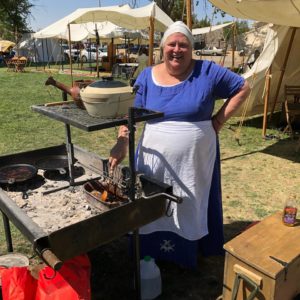We really wanted to demo a large cut of meat roasted on a spit, and beef had to be our choice. Beef was a rather expensive meat choice in much of England, and possibly in the Lowlands of Scotland, as well, as raising cattle required a great land investment. But, archaeological evidence suggests that beef was the most commonly eaten meat in the Scottish Highlands during the Middle Ages. Sheep were grown almost everywhere for wool, and mutton was the second most popular source of meat, followed by pig, goat, horse and deer. Fresh meat could be cured with dry salt, pickled, or smoked to preserve. Chickens and geese were also kept for food, and people who lived near rivers or the sea ate fish and other seafood.
The main reason we wanted to demo spit-cooking was that we wanted to show this common method of preparing large amounts of meat (which were often rather tough cuts, due to either the location they were found on the animal, or due to them being from an older animal). Tough cuts of meat were usually boiled, or stewed, a favorable method that also produced a tasty broth that could be saved and utilized later for, say, a pottage or a sauce.
I’m going to have to update this post, later, with better pictures. But, this photo shows the spit setup we used, with a pan located directly under where the meat would be, to catch the drippings as the meat was cooking and basted. The actual fire area would be located beside the meat, not under it (dripping fat into a fire is a big safety no-no). The drippings would be saved and, after the meat was cooked and removed from the fire and allowed to rest (to keep the juices from running out and leaving the meat dry), the meat would be sliced and returned to a sauce made from the drippings.
For our recipe, we looked to the earliest recipes we could find for seasoning beef in Scotland. We seasoned the meat with salt, pepper, allspice, nutmeg, clove, mace, thyme and savory. As it cooked, we basted it with a combination of beef stock & ale, which we later used to make a sauce with the drippings, more stock & ale, additional vinegar and some more of the same spices.

